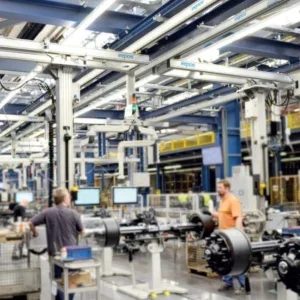Whiting specialises in custom designed and pre-engineered cranes with capacities up to 800 US tons (725t) per hook. It also manufactures rail carriage service equipment. Although Whiting has a maintenance operation, most of its business is in heavy-duty new cranes. ‘When the customer gets that piece of equipment, his expectation and ours is that we won’t have to hear from him for 30 years because the thing will be running smoothly,’ says president and CEO Jeff Kahn.
Kahn says that packaged hoists are entering the heavier market. ‘You get that always-coming around conflict: as a buyer do I save a dollar now at the expense of risking downtime later or do I buy a 50 year crane. There’s been more attempts to sell equipment that even the customer understands will only last 10 years. If the pressure is on to save a dollar now, it’s to save a dollar now.’
It is not a battle Whiting is normally set up to win. ‘If someone’s selling a standardized crane in a higher capacity, and they are knocking them off in volume, it’s going to be difficult for one company that is building one custom unit to perfectly meet the needs of the customer to necessarily be price competitive,’ Kahn says.
To keep the customer’s business, Whiting has sometimes had to offer an alternative crane design to fit a tighter budget. ‘For the right customer, alternative Y is the right answer. I’m not going to say that a packaged hoist doesn’t make sense in certain applications. We have to understand what the customer’s needs are and then try to find best solution. And sometimes the customer going in doesn’t know what their needs are. We’ve seen that too. They’ll come up with specs this thick, and then ultimately they’ll say, “You’ve met all of those but somebody else came in with a specification that was 20% cheaper.”’
Kahn says his main strategy has been to improve customer service. ‘The market has become more service-orientated, customers have become more demanding not only in terms of price, but in velocity of delivery, and their expectations for maintainability and reliability of the product and I think the more demanding the customer is, hopefully the better position we’re going to be to meet those needs.’
‘I have a whiteboard in my office and I keep the words “the customer” on the top of the white board at all times because no matter what we’re discussing, ultimately that’s what it comes down to, listening to the customer.’
Four years ago, the company implemented a lean manufacturing system and moved into a new manufacturing facility. ‘What I’ve tried to do is to get all the internal people focussed on the end user rather than having a lot of functional silos where people throw things over from one department to another.’
He has also been simplifying the crane design process. Although the cranes are custom-designed, the company is of course not redesigning the crane from the beginning for every job. ‘We have some standard parametric models that we use. I don’t know if I’d go so far as to call it ‘mass customisation’ but it’s developing models that can be altered by changing many different parameters but still meet the customer’s needs. It can be altered quickly and be produced quickly.’
Kahn says the company has been working on streamlining and speeding up those engineering and manufacturing processes.
Demand has increased for faster delivery, Kahn says – to as short as two months. ‘Our biggest issue in the last six months has been making sure we can get all the orders to the customers on time. It’s easy to think in the back of your mind, “You’ve been talking about that project for a year, why didn’t you order sooner?” but a customer is a customer, and there are funding issues often, particularly with new plants, and when they are ready, they want to go sometimes really quickly.’
Kahn says he suspects Whiting’s very success encourages customers to expect cranes to be delivered sooner. ‘Lean and the other management tools that have been used for reengineering an organisation are about improving businesses and making them react better. I think as time goes on delivery times will continue to compress as organisations get more and more efficient. If you don’t improve you die.’






